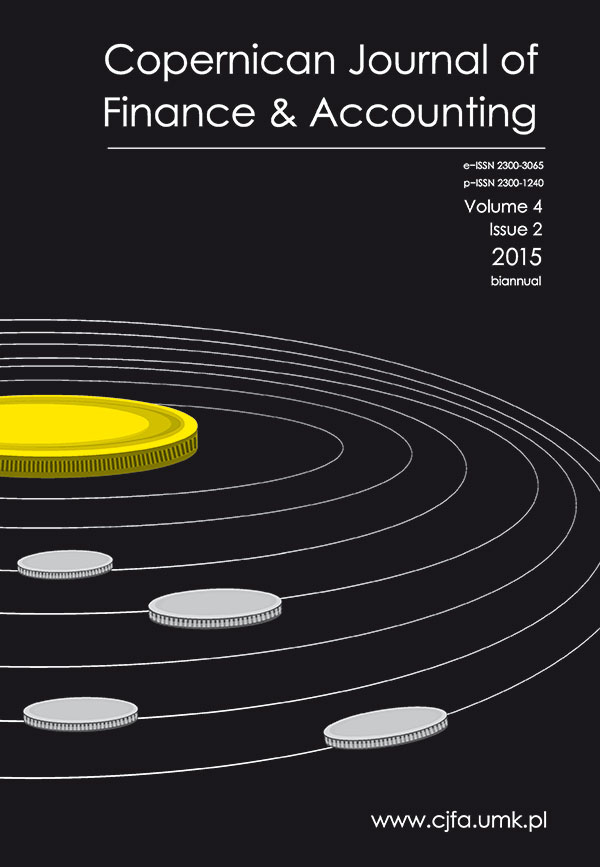Evaluation of ATM Cash Demand Process Factors Applied for Forecasting with CI Models
DOI:
https://doi.org/10.12775/CJFA.2015.025Keywords
computational intelligence, regression, time series forecasting, cash management, data-based forecasting, daily cash flowAbstract
The purpose of cash management is to optimize distribution of cash. Effective cash management brings savings to retail banks that are related to: dormant cash reduction; reduced replenishment costs; decrease of cash preparation costs; reduction of cash insurance costs. Optimization of cash distribution for retail banking in ATM and branch networks requires estimation of cash demand/supply in the future. This estimation determines overall cash management efficiency: accurate cash demand estimation reduces bank overall costs. In order to estimate cash demand in the future, cash flow forecasting must be performed that is usually based on historical cash point (ATM or branch) cash flow data. Many factors that are uncertain and may change in time influence cash supply/demand process for cash point. These may change throughout cash points and are related to location, climate, holiday, celebration day and special event (such as salary days and sale of nearby supermarket) factors. Some factors affect cash demand periodically. Periodical factors form various seasonality in cash flow process: daily (related to intraday factors throughout the day), weekly (mostly related to weekend effects), monthly (related to payday) and yearly (related to climate seasons, tourist and student arrivals, periodical celebration days such as New Year) seasons. Uncertain (aperiodic) factors are mostly related to celebration days that do not occur periodically (such as Easter), structural break factors that form long term or permanent cash flow shift (new shopping mall near cash point, shift of working hours) and some may be temporal (reconstruction of nearby building that restricts cash point reachability). Those factors form cash flow process that contains linear or nonlinear trend, mixtures of various seasonal components (intraday, weekly, monthly yearly), level shifts and heteroscedastic uncertainty. So historical data-based forecasting models need to be able to approximate historical cash demand process as accurately as possible properly evaluating these factors and perform forecasting of cash flow in the future based on estimated empirical relationship.
References
Brentnall, A.R., Crowder, M.J., & Hand, D.J. (2008). A statistical model for the temporal pattern of individual automated teller machine withdrawals. Journal of the Royal Statistical Society: Series C (Applied Statistics). 57(1). 43–59. http://dx.doi.org/10.1111/j.1467-9876.2007.00599.x.
Brentnall, A.R., Crowder, M.J., & Hand, D.J. (2010a). Predicting the amount individuals withdraw at cash machines using a random effects multinomial model. Statistical Modeling. 10(2). 197–214. http://dx.doi.org/10.1177/1471082X0801000205.
Brentnall, A.R., Crowder, M.J., & Hand, D.J. (2010b). Predictive-sequential forecasting system developement for cash machine stocking. International Journal of Forecasting.26. 764–776.
Chih-Chung, C., & Chih-Jen, L. (2011). LIBSVM: a library for support vector machines. ACM Transactions on Intelligent Systems and Technology. 2(27). 1–27. http://www.csie.ntu.edu.tw/~cjlin/libsvm (accessed: 29.03.2015).
Cortes, C., & Vapnik, V. (1995). Support-vector networks. Machine Learning. 20(3). 273–297. http://dx.doi.org/10.1007/BF00994018.
Darwish, S.M. (2013). A methodology to improve cash demand forecasting for ATM network. International Journal of Computer and Electrical Engineering. 5(4). 405–409. http://dx.doi.org/10.7763/IJCEE.2013.V5.741.
Ekinci, Y., Lu, J.C., & Duman, E. (2015). Optimization of ATM cash replenishment with group-demand forecasts. Expert Systems with Applications. 42(7). 3480–3490. http://dx.doi.org/10.1016/j.eswa.2014.12.011.
Gurgul, H., & Suder, M. (2013). Modeling of withdrawals from selected ATMs of the Euronet network. AGH Managerial Economics. 13. 65–82. http://dx.doi.org/10.7494/manage.2013.13.65.
Hagan, M.T., & Menhaj, M. (1994). Training feed-forward networks with the Marquardt algorithm. IEEE Transactions on Neural Networks. 5(6). 989–993.
Huang, G.B., Zhu, Q.Y., & Siew, C.K. (2006). Extreme learning machine: theory and applications.
Neurocomputing. 70. 489–501. http://www.ntu.edu.sg/home/egbhuang/elm_codes.html (accessed: 29.03.2015).
Jang, J.S.R. (1993). ANFIS: adaptive-network-based fuzzy inference systems. IEEE Transactions on Systems, Man, and Cybernetics. 23(3). 665–685. http://dx.doi.org/10.1109/21.256541.
Kumar, P., & Walia, E. (2006). Cash forecasting: An application of artificial neural networks in finance. International Journal of Computer Science & Applications. 3(1).61–77.
Laukaitis, A. (2008). Functional data analysis for cash flow and transactions intensity continuous-time prediction using Hilbert-valued autoregressive processes. European Journal of Operational Research. 185(3). 1607–1614. http://dx.doi.org/10.1016/j.ejor.2006.08.030.
Pelckmans, K., Suykens, J.A.K., Van Gestel, T., De Brabanter, J., Lukas, L., Hamers, B., De Moor, B., & Vandewalle, J. (2002). LS-SVMlab : a Matlab/C toolbox for Least Squares Support Vector Machines. Internal Report 02-44, ESAT-SISTA, KU Leuven, Leuven, Belgium, viewed 14 May 2015. http://www.esat.kuleuven.be/sista/lssvmlab/old/lssvmlab_paper0.pdf (accessed: 29.03.2015).
Rodrigues, P., & Esteves, P. (2010). Calendar effects in daily ATM withdrawals. Economics Bulletin. 30(4). 2587–2597.
Rumelhart, D.E., Hinton, G.E., & Williams, R.J. (1986). Learning representations by backpropagation errors. Nature. 323. 533–536.
Simutis, R., Dilijonas, D., & Bastina, L. (2008). Cash demand forecasting for ATM using neural networks and support vector regression algorithms. Proceedings of the twentieth EURO mini conference on continuous optimization and knowledge-based technologies (EurOPT-2008). Neringa. Lithuania. 416–421.
Simutis, R., Dilijonas, D., Bastina, L., & Friman, J. (2007). A flexible neural network for ATM cash demand forecasting. Proceedings of the sixth WSEAS international conference on computational intelligence, man-machine systems and cybernetics (CIMMACS 07). 162–165.
Specht, D.F. (1991). A general regression neural network. IEEE Transactions on Neural Networks. 2(6). 568–576.
Suykens, J.A.K., Van Gestel, T., De Brabanter, J., De Moor, B., & Vandewalle, J. (2002). Least Squares Support Vector Machines. World Scientific. Singapore.
Tipping M.E. (2001). Sparse Bayesian learning and the relevance vector machine. Journal of Machine Learning Research. 1. 211–244. http://www.miketipping.com/sparsebayes.htm (accessed: 29.03.2015).
Wagner M. (2010). Forecasting daily demand in cash supply chain. American Journal of Economics and Business Administration. 2(4). 377–383. http://dx.doi.org/10.3844/ajebasp.2010.377.383.
Downloads
Published
How to Cite
Issue
Section
Stats
Number of views and downloads: 731
Number of citations: 0



